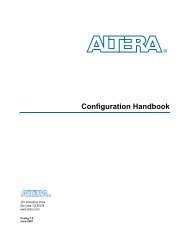TMS320VC5409 Fixed-Point Digital Signal ... - Texas Instruments
TMS320VC5409 Fixed-Point Digital Signal ... - Texas Instruments
TMS320VC5409 Fixed-Point Digital Signal ... - Texas Instruments
- No tags were found...
Create successful ePaper yourself
Turn your PDF publications into a flip-book with our unique Google optimized e-Paper software.
Functional OverviewThe HPI8/16 functions as a slave and enables the host processor to access the on-chip memory of the 5409.A major enhancement to the 5409 HPI over previous versions is that it allows host access to the entire on-chipmemory range of the DSP. The HPI8/16 does not have access to external memory. The host and the DSP bothhave access to the on-chip RAM at all times and host accesses are always synchronized to the DSP clock.If the host and the DSP contend for access to the same location, the host has priority, and the DSP waits forone HPI8/16 cycle. Note that since host accesses are always synchronized to the 5409 clock, an active inputclock (CLKIN) is required for HPI8/16 accesses during IDLE states, and host accesses are not allowed whilethe 5409 reset pin is asserted.0000hReserved005Fh0060h007Fh0080h7FFFh8000hFFFFhScratch-PadRAMOn-Chip RAM(32K x 16 Bits)ReservedFigure 3−7. 5409 HPI Memory Map3.3.1.2 Standard 8-Bit ModeThe HPI8/16 interface consists of an 8-bit bidirectional data bus and various control signals. Sixteen-bittransfers are accomplished in two parts with the HBIL input designating high or low byte. The hostcommunicates with the HPI8 through three dedicated registers — HPI address register (HPIA), HPI dataregister (HPID), and an HPI control register (HPIC). The HPIA and HPID registers are only accessible by thehost, and the HPIC register is accessible by both the host and the 5409. If the HPI is disabled (HPIENA = 0)or in HPI16 mode (HPI16 = 1), the 8-bit bidirectional data pins HD0−HD7 can be used as general-purposeinput/output (GPIO).3.3.1.3 16-Bit Nonmultiplexed ModeIn nonmultiplexed mode, a host with separate address/data buses can access the HPI16 data register (HPID)via the HD 16-bit bidirectional data bus, and the address register (HPIA) via the 16-bit HA address bus,external address and data pins, A0–A15 and D0–D15, respectively. The host initiates an access with thestrobe signals (HDS1, HDS2, HCS) and controls the direction of the access with the HR/W signal. The HPI16can stall host accesses via the HRDY signal. Note that the HPIC register is not available in nonmultiplexedmode since there are no HCNTL signals available. All host accesses initiate a DMA read or write access. TheHPI16 nonmultiplexed mode does not support host-to-DSP and DSP-to-host interrupts. When the HPI isdisabled or in HPI16 mode, HD0–HD7 can be configured as general-purpose input/output (GPIO). The HPI16pin is sampled at RESET. The HPI16 pin should never be changed while the device RESET is HIGH.30 SPRS082FApril 1999 − Revised October 2008
















